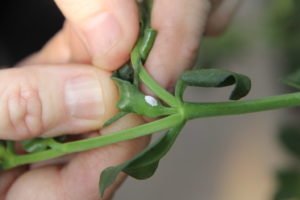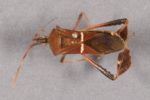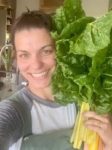The August Vegetable Garden Checklist by Paula Wolfel
What a treat we have gotten with this summer’s rain! My garden definitely looks different this August than it has looked the last few years at this time. Rain barrels are filled up and the plants that have survived the heat are looking happy. We are not out of the clear yet though. August usually brings high temperatures and little precipitation so keep an eye on the radar and supplement watering with irrigation and use shade cloth when your plants need a break. Consider signing up for weekly watering recommendations at TexasET Network based on the weather station located nearest you.
Last Call for Warm Season Vegetables
August is the last month to plant warm season crops. It is best to stick with varieties that produce in 60 days or less if you want a harvest before the winter frost arrives. This information should be on the seed packet or catalog description. The first frost date in Austin is usually the first week of December, although in 2019 it arrived as early as Halloween. You can deep dive into those numbers based on your closest weather station using data from the National Oceanic and Atmospheric Administration (NOAA).
If you are ready to move on from the warm season vegetables, then now is the time to start planning your fall garden. You can plant seeds inside under grow lights or outside in pots, placing them in bright shady spots. Seedlings will be ready to transplant in about 6 weeks. Just make sure they don’t dry out in the heat.
August Vegetable Garden To-Do List
FERTILIZE
- Hold off on fertilizing this month. Heat stress plus fertilizer can kill your plants because they can’t get enough water when temperatures spike during the day. Wait until it cools down next month.
WATER
- If the opportunity allows, it is most efficient to irrigate in the morning. For plants to most efficiently absorb water, their stomata need to be open. In most plants, the stomata are only open in the presence of sunlight. If you water at night, water is not being absorbed until the stomata are open. While the excess water sits in the soil during the night, it evaporates (causing inefficiency and water “loss”) and can increase the potential for fungal infection.
- Water is important during the fruit stage of plant development so make sure plants like tomatoes, melons, okra, squashes, pumpkins, eggplant and Southern peas get a dependable and ample supply of moisture during flowering and fruit enlargement.
PLANTING
Seeds
- Beans, snap and lima (all month)
- Beets (late month)
- Carrots (late month)
- Corn (early-mid month)
- Cucumber (all month)
- Greens, warm season (early month)
- Okra (early month)
- Peas, Southern (early-mid month)
- Potatoes, Irish (mid-late month)
- Squash, Summer (all month)
- Squash, Winter (early-late month)
- Turnip (late month)
Seeds or Transplants
- Chard, Swiss (late month)
- Collards (late month)
- Kholrabi (late month)
- Mustard (late month)
Transplants
- Broccoli (late month)
- Brussels sprouts (late month)
- Cabbage (late month)
- Cauliflower (late month)
- Eggplants (early-mid month)
- Peppers (early-mid month)
- Tomatoes (early-mid month)
SOIL
- Mulch well to conserve moisture in the soil.
- Get compost ready, or research soil yards for best compost to purchase, so you have plenty for next month when fall planting begins.
DISEASES/PEST

Watch out for mealy bug infestations.
- Aphids, white flies, and mealybugs or scale continue to be a nuisance this month; they suck plant sap from leaves and stems. The best defense are natural predators such as lady bugs, lacewings, and praying mantis; they should arrive naturally. You can also treat with blasts of water or insecticidal soaps. Sooty mold fungi can grow on the excess honeydew secretions left from these insects. If this occurs, remove the leaves from the plant.

Leaf-footed bug
- Conchuela stink bugs (Chlorochroa ligata), Leaf-footed Bugs (Leptoglossus phyllopus), Harlequin Bugs (Murgantia histrionica), and Squash Bugs (Anasa tristis) also continue to be a nuisance in the garden. All these bugs have piercing mouthparts that suck juices from plant leaves, stems, and fruits. They can be picked up and squashed, or thrown into a cup of soapy water. Check the bottom of leaves for eggs. They reproduce quickly so if left unchecked you will have dozens within days.
MAINTENANCE
- Keep the leaves of your vegetable plants off the ground to help prevent the spread of disease.
- Trim any leaves that have yellowed, or have succumbed to disease or pests
- Pull any plants that are infested with pest damage or disease; whatever they are suffering from will get worse during the stress of the summer heat.
- Melons, peppers, cucumbers, and eggplant can handle Texas heat better than tomatoes. Keep them well watered mulched. Even if they pause production during summer’s peak heat, they will power through and produce bumper crops in the fall.
- Check the underside of leaves for pest eggs.
- Keep on top of weeds who are competing with your plants for water and providing cover for pests.
HARVEST
Sometimes it’s hard to tell when something should be picked. Here are a few tips.
Melons
- When the tendril closes to the fruit becomes brown and dries up
- When the spot where the fruit touches the ground becomes more prominent and changes color (typically yellow)
- When tapped, ripe melons have a hollow, dull sound
Cucumbers, Squash, and Zucchini
- They can be harvested at any size
- They taste best when they are harvested smaller
- The bigger they get the bigger the seeds inside, and they are more watery and bitter
Peppers
- They are ready to be harvested when they change color; for jalapenos or other green peppers, this means a deepening to a dark green
Eggplant
- When they are firm and shiny
- You can’t pick them too early
- Similar to cucumbers and squash, if the eggplants remain on the plant too long it will become bitter and have large seeds inside
Pumpkins
- In general, pumpkins can be left on the vine until autumn but the longer it sits, the longer it is exposed to pests, animals, and the summer sun
- Harvest 90-120 days after seeds are planted
- When the vines begin to die back
- When the stem that attaches a pumpkin to the vine turns from green to brown
- The outer rind will become hard as it ripens
- When the pumpkin reaches a deep version of its mature color (most will be orange, but some variants are green, white, yellow, red)
Tomatoes
- When they a deep version of their mature color (become familiar with the color of the vegetable you are growing)
- Tomatoes can be picked when they are green and have a tint of color change and then can ripens on your kitchen counter, especially near bananas or in a brown paper bag, or in a sunny window sill- this is especially useful if animals are eating your tomatoes or you plan to travel for a long period of time
Check out the Texas A&M AgriLife Extension Dinner Tonight website for ideas and recipes for preparing fresh produce.
Additional Resources
Weather Strategies for Austin Gardens
Watch the Vegetable Gardening in Central Texas Webinar
Vegetable Planting Calendar (Español, 繁体中文)
Recommended Vegetable Varieties for Travis County
Easy Gardening Series Detailed tips from Texas A&M University AgriLife Extension on specific crops and practices.
Vegetable Gardening in Austin Resource hub for all things vegetables for Travis County
Plant Rotations, Successions and Intercropping
Monthly Gardening Calendar for Austin and Central Texas
Sustainable Food Center Farmers Markets
About Paula Wolfel
 Paula Wolfel joined the Travis County Master Gardener program in 2022 and has taken extra training to become a vegetable specialist. She grew up in the suburbs of Chicago learning how to garden from both her father—a Sicilian vegetable and fruit tree gardener—and both her grandmothers, and then spent years in Virginia gardening. Paula loves gardening because she finds it to be a grounding force- it gets her out of her head and into the present. She loves the pride that comes with cooking a meal for her family with every ingredient coming from her garden… and then the humility she feels when she loses an entire crop because of Mother Nature. She finds gardening to be wisdom, lessons, best practices passed down generation to generation, season to season and hopes to share that with you.
Paula Wolfel joined the Travis County Master Gardener program in 2022 and has taken extra training to become a vegetable specialist. She grew up in the suburbs of Chicago learning how to garden from both her father—a Sicilian vegetable and fruit tree gardener—and both her grandmothers, and then spent years in Virginia gardening. Paula loves gardening because she finds it to be a grounding force- it gets her out of her head and into the present. She loves the pride that comes with cooking a meal for her family with every ingredient coming from her garden… and then the humility she feels when she loses an entire crop because of Mother Nature. She finds gardening to be wisdom, lessons, best practices passed down generation to generation, season to season and hopes to share that with you.
